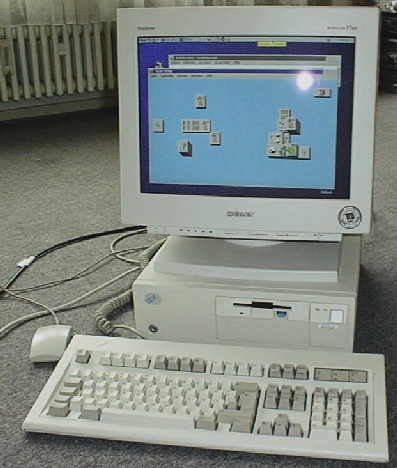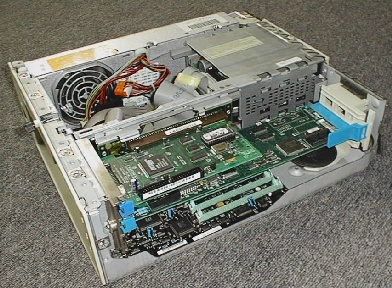
Click here or click onto the photo for a full size version of this picture.
The first generation of the Model 76/77 were already nice implementations for the time they were built, but technical progress never stands and it did not take long that an improvement became necessary. IDE disks became rapidly faster and cheaper, while SCSI disks necessary for the Bermuda planar to load its microcode became more and more unattractive for desktop workstations, the market the 76/77 were targeted at. Furthermore, I guess most users probably weren't very happy with the fact that there were only two slots available for extensions. And last but not least, development of 486 processors continued and newer CPUs demanded a supply voltage of 3.3V the Bermuda couldn't provide without the help of clumsy voltage regulator sockets. So it was clear that a new planar had to be designed, commonly known as the 'Lacuna'. It was standard in the 'i' and 's' series of the 76/77, and it was offered as a planar upgrade for people who had already bought the older models. To the best of my knowledge, the only difference between the 'i' and 's' series is that the 's' were shipped with a Fast SCSI controller, a rebranded Future Domain MCS-700.

Click here or click onto the photo for
a full size version of this picture.
A look onto the back reveals two changes: the onboard SCSI controller has been removed. Instead, there's the FDomain in the upmost expansion slot. The external connector is a standard 50-pin HD connector. Welcome, IBM, in the world of standardized connectors! Though one has to admit that such an 'error' wouldn't have happened if you'd actually have built that controller yourself...the space freed up on the back plate is now 'filled' with the VGA plug.

Click here or click onto the photo for
a full size version of this picture.
Since only the planar was modified, a first look at the innards doesn't reveal many differences; what is not visible on this photo is that the SIMM sockets may now take modules of up to 16 Mbytes, allowing a maximum memory of 64 Mbytes.

Click here or click onto the photo for
a full size version of this picture.
This is where the real differences become visible: the CPU is now located on a ZIF socket which allows easy swapping of processors. The need of two places for processors (a soldering area for SXes in PQFP and a PGA socket for the rest) is gone, and the freed-up space plus the space the SCSI controller needed became free for an on-board graphics card. It is based on the S3-928, a quite popular and good choice at that time. The SVGA commands 1 Mbyte of video RAM, and an extension via a special connector is possible. The connector is proprietary, IBM couldn't let completely off them...
Improvements around the processor are also visible. Directly next to the socket is a connector for a 3.3V voltage regulator module, needed for the DX4-100 processor offered by IBM as the top-model. I have heard reports that the 133MHz AM5x86 also works nice... For 5V CPUs like the DX2/66 in this machine, the connector is simply shorted via some jumpers.
In contrast to the Bermuda, the Lacuna optionally allows the use of an L2 cache module. IBM offered both modules with 128K or 256K of cache. They are however not required for operation.
The IDE port is next to the floppy connector. Of course, don't expect anything more than PIO Mode 0 (~1.5 to 2 Mbytes/sec), but the nice thing is that IBM later offered BIOS upgrades (revision 08) that allowed the use of drives larger than 504MB. This machine has a 4.3Gbyte Seagate drive and works quite nice :-)
- Processor:
- Intel i486DX2 @ 66 MHz
- Coprocessor:
- integrated into CPU
- Cache:
- 8K internally in CPU, 128K L2 cache module
- Memory:
- 32 Mbytes (options range from 4M to 64M)
- Bus:
- 3 MCA slots (32 bit)
- Interfaces (onboard):
-
- Mouse, Keyboard
- 2 x Serial
- 1 x Parallel
- Floppy (2.88M), allows attachment of up to 3(!) drives
- IDE (1 channel)
- SVGA (S3-928-based)
- Add-on cards:
-
- 3COM 3C523 Ethernet adapter
- Future Domain MCS-700 SCSI adapter
- Operating System(s):
-
- OS/2 Warp Version 4
- Caldera OpenDOS 7.01
- Linux 2.2 (Slackware-based)
- Useful Links: